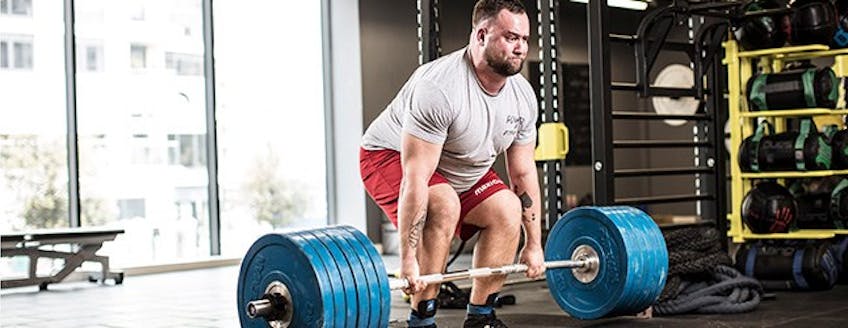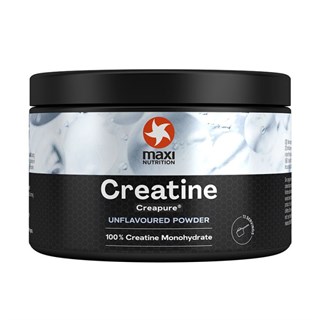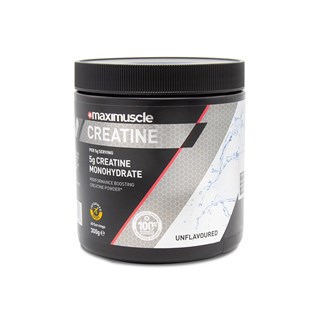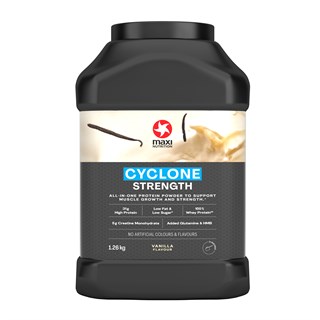Powerlifting Workout
What is powerlifting?
In the land of gym goers, not everyone is created equal. While bodybuilders might be ripped and aesthetic – powerlifters care about one thing and one thing only: the weight on the bar.
The sport is a growing one, separated into weight classes and inviting participants to compete in ‘meets’ where they are tested on their best 1 rep max for three lifts: the bench press, the squat and the deadlift.
There are two ‘styles’ of powerlifting – raw and equipped. Users who choose equipped don bench shirts and squat suits, among other specialist items, to help them move the most weight they possibly can. Raw (classic in the UK) only permits knee sleeves, a belt, wrist wraps, chalk and singlets – no other helpful equipment is allowed.
Whether you aim to compete in the sport or just want to train for strength, a powerlifting style training plan is the perfect way to boost your strength (and, if you eat enough during the plan, your size).
Benefits of powerlifting training
Powerlifting training plans are centered on the three main compound lifts. These lifts recruit the most muscles and put the most stress on your central nervous system – which in turn means they release the most hormones.
Most training plans use these compound lifts – but a powerlifting training plan is written around them. This is because they are designed to help you push up your one rep maximum and lift the heaviest you ever have so you can dominate a competition or just be the strongest you’ve ever been.
Not only will you grow stronger, you’ll also build mental fortitude as you tackle personal bests.
The only real negative is that because this plan doesn’t use isolations, you may miss out on the kind of area specific muscle toning you get from bodybuilding plans.
However, if getting stronger than you’ve ever been appeals to you, keep reading to get your hands on our powerlifting training plan.
MaxiNutrition (Formerly Maximuscle) Powerlifting Training Program
Before you start this plan, you’ll need to test your maximum one rep max (1RM) in the bench press, squat and deadlift. We will aim to use these figures to create your program.
Rest: Make sure you get adequate rest in between these training days. You’ll need to refuel, rehydrate and recover to maximize results.
Weeks 1-3 (Initial Volume Phase)
During this phase, you should aim to add to your workout each week. Push your percentage up by 2.5% each week. For example, if your bench press max is 100kg and in week 1 you are doing 5x5 at 75kg, in week two aim for 77.5kg.
- Day A – Bench
- Main Lift: 5 x 5 Bench Press at 75% of your 1RM. Ensure the bench bar touches your chest before pressing.
- Accessory Lift: 3 x 6 Incline Dumbbell Bench Press. Pick a weight that feels heavy but comfortable.
- 3 x 8-10 Pull Ups.
- Day B – Squats
- Main Lift: 5 x 5 Low Bar Squats at 75% of your 1RM. Make sure you hit ‘depth’ – which in powerlifting is the crease of your hip going lower than your knee.
- Accessory Lift: 3 x 8 Front Squats at 60% of your 1RM.
- Day C - Deadlift
- Main Lift: 5 x 5 Deadlift at 75% of your 1RM.
- 3 x 5 Pause Squats at 75% of your 1RM.
- Day D – Accessory Lifts
- 3 x 8 Weighted Pull Ups.
- 3 x 8 Military Press at 60% of your bench max.
- 3 x 8 Bent Over Rows. Choose a weight around 90% of your bodyweight.
Weeks 3-5 (Heavy phase)
You’ll now start lifting heavier for less reps. Allow your body time to get used to this by eating plenty of protein and getting rest between workouts.
- Day A - Bench
- Bench Press
- Set 1: 5 x 85% 1RM
- Set 2: 4 x 87.5% 1RM
- Set 3: 3 x 90% 1RM
- 3 x 10 Weighted Pull Ups.
- 3 x 10 Bent Over Rows.
- Day B – Squats
- Low Bar Squat
- Set 1: 5 x 85% 1RM
- Set 2: 4 x 87.5% 1RM
- Set 3: 3 x 90% 1RM
- Accessory Lift: 3 x 5 Front Squats at 80% of your 1RM.
- Day C - Deadlift
- Deadlift
- Set 1: 5 x 85% 1RM
- Set 2: 4 x 87.5% 1RM
- Set 3: 3 x 90% 1RM
- Set 4: 1 x 95% 1RM
- 3 x 8 Pull Ups.
- Day D – Specialist Lifts
- Pause Squats
- Set 1: 5 x 80% of 1RM
- Set 2: 3 x 85% of 1RM
- Set 3: 3 x 85% of 1RM
- Pause Bench (pause at the bottom of the movement for 2 seconds before pressing)
- Set 1: 5 x 75% of 1RM
- Set 2: 3 x 80% of 1RM
- Set 3: 3 x 80% of 1RM
Week 6 (Testing Week)
- Day A - Bench
- Bench Press
- Warm Up
- Set 1: 2 x 80% 1RM
- Set 2: 2 x 85% 1RM
- Set 3: 1 x 95% 1RM
- Set 4: 1 x 105% of 1RM
- Set 5: If successful with set 4 – 1 x 110% 1RM. If failure, 2 x 95% 1RM. 3 x 5 85% Incline Bench Press.
- Day B – Squats
- Low Bar Squat
- Warm Up
- Set 1: 2 x 80% 1RM
- Set 2: 2 x 85% 1RM
- Set 3: 1 x 95% 1RM
- Set 4: 1 x 105% of 1RM
- Set 5: If successful with set 4 – 1 x 110% 1RM. If failure, 2 x 95% 1RM.
- Accessory Lift: 3 x 3 Front Squats at 90% of your 1RM.
- Day C - Deadlift
- Deadlift
- Warm Up
- Set 1: 2 x 85% 1RM
- Set 2: 2 x 90% 1RM
- Set 3: 1 x 95% 1RM
- Set 4: 1 x 105% of 1RM
- Set 5: If successful with set 4 – 1 x 110% 1RM. If failure, 2 x 95% 1RM.
- 3 x 5 Weighted Pull Ups – Aim for maximum weight.
Final thoughts
If you’ve followed this plan through, you’ve hopefully broken your 1RM. If you haven’t – you’ll have increased your strength at reps. Don’t worry if you can’t muster the big lift that week. Try again in subsequent weeks.
Once you’ve beaten your 1 rep numbers for each lift, start the plan again with that new 1RM. You can do this repeatedly in order to build strength, or look up other powerlifting training plans that stretch over longer periods.
Remember: all strength gains need to be supported. Check out the MaxiNutrition (Formerly Maximuscle) range of protein supplements to help your body’s natural muscle building processes.
This training programme is only suitable for an experienced person in good physical condition. Please consult a training expert before engaging in this programme. You engage in this fitness programme at your own risk. We do not accept any liability for personal injury, loss or damage you may suffer as a result of attempting any of the activities outlined in this training programme.

















